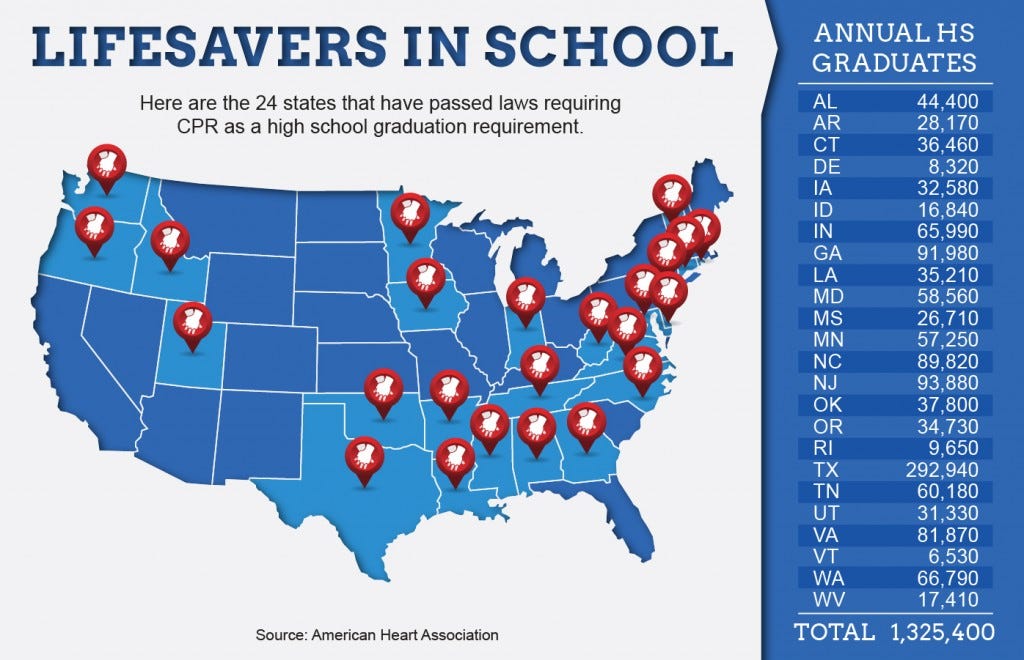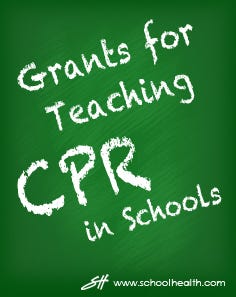Grant for Teaching CPR in Schools
- Aug 16, 2015
- 0 Comments
 This blog has been written by John Meiners. John Meiners is Executive Vice President of Emergency Cardiovascular Care (ECC) Programs and International Strategies for the American Heart Association (AHA). In this key role, John leads AHA’s global effort to increase survival from cardiac arrest by working toward AHA’s global goal of reducing mortality from cardiovascular diseases and stroke by 25% by 2025.
This blog has been written by John Meiners. John Meiners is Executive Vice President of Emergency Cardiovascular Care (ECC) Programs and International Strategies for the American Heart Association (AHA). In this key role, John leads AHA’s global effort to increase survival from cardiac arrest by working toward AHA’s global goal of reducing mortality from cardiovascular diseases and stroke by 25% by 2025.
Creating the Next Generation of Lifesavers
In the United States, 38 people every hour will have a cardiac arrest outside of the hospital. However, only 10 percent of these victims will survive. Seventy percent of the time, cardiac arrests will occur in the home. Lifesaving CPR performed by a bystander can double or even triple a person’s chance of surviving a cardiac arrest. The life you save by performing CPR is most likely to be your own family or friend!
Students play an integral part of increasing survival from cardiac arrest. Twenty-four states now require all students to be trained in CPR, with hands-on practice on a manikin, before graduating from high school. That means approximately 1.2 million students (nearly 40 percent of the U.S. student population) will be trained in CPR each year! The American Heart Association (AHA) is actively involved in helping to create the next generations of lifesavers who will help increase the chance that a cardiac arrest victim has the help he or she needs until paramedics arrive.

Apply for a Grant to Train Your Students
 In the first year of the AHA-Ross Dress for Less Stores CPR in Schools Program, we have trained more than 330,000 middle school students in life-saving CPR. Over three years, more than 1,000,000 students in 33 states will learn CPR. For more information about this successful CPR in Schools Program, please visit here.
In the first year of the AHA-Ross Dress for Less Stores CPR in Schools Program, we have trained more than 330,000 middle school students in life-saving CPR. Over three years, more than 1,000,000 students in 33 states will learn CPR. For more information about this successful CPR in Schools Program, please visit here.We are excited to announce our newest grant program for high schools! Because of the generous donation from the Ross Stores Foundation, 250 high schools across the country will receive 2 FREE CPR in Schools Training Kits™ in the 2015-2016 school year. This all-in-one kit contains 10 manikins and materials for school teachers or administrators to train hundreds of students, as well as online resources to make implementation easy. Students learn the core skills of CPR in under 30 minutes, and it contains everything needed to learn CPR, AED skills and choking relief in school classroom settings. The easy-to-use kit utilizes the AHA’s latest science guidelines and it is portable, allowing for easy storage. It was developed for educators, school nurses or even student leaders to train groups of 10-20 students at once in a school setting.
If you’d like to learn more about getting your school involved, visit www.heart.org/rosscprschoolgrant.
Hurry! The deadline for grant applications is September 30th, 2015.
Remember, cardiac arrests can happen to anyone, anywhere, and when you least expect it.
Abby Snodgrass is one of those students that was able to learn CPR in high school and become a lifesaver. This is her story:
Abby was out shopping when she heard commotion on the next aisle. She ran to see what was going on and saw an 11-month-old baby who suddenly stopped breathing. Abby had recently learned CPR at her Hillsboro High school in Missouri and immediately starting performing the lifesaving technique. The baby eventually started breathing again, and emergency responders said if Abby had not acted so fast, the baby might have died.
This is just one of the many great stories of students saving lives through CPR they learned in school, thanks in part to partners like Ross Stores who donate funds to provide grants for hundreds of high schools across the country. While we’ve made some great progress over the years, we also need your help to expand this program across the country! If CPR training is not currently required in your state, join us in supporting legislation at http://becprsmart.org.
We thank you for being such an integral part of creating safer communities. Together, we can increase survival from cardiac arrest.
For incredible save stories and insightful SCA information please visit the Sudden Cardiac Arrest Foundation.
